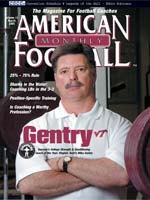AMERICAN FOOTBALL MONTHLY THE #1 RESOURCE FOR FOOTBALL COACHES
|
|
Article Categories
|
Heavy ImpactStrength and conditioning coaches and facilities have taken the game of football to a whole new level by: Jeff Davis© More from this issue
|
It’s the youngest, and
certainly in many respects, the most important element in developing
winning athletic programs, especially football, other than the head
coach himself. The strength and conditioning coach and his staff
can be difference makers between a winning program and mediocrity.
Before the early 1960s, only a handful of athletes dared to try
weight lifting. “They used to think you’d become muscle-bound,”
says Mike Burgener, for decades, the esteemed strength and conditioning
coach at Rancho Buena Vista High School near San Diego.
That old saw still held true for Burgener when he was a high....The full article can only be seen by subscribers.
Subscribe today!

|
|
|
NOT A SUBSCRIBER?
Subscribe
now to start receiving our monthly magazine PLUS get INSTANT
unlimited access to over 4000 pages of 100 percent football coaching
information, ONLY available at AmericanFootballMonthly.com!
|
|
|
HOME
|
MAGAZINE
|
SUBSCRIBE
|
ONLINE COLUMNISTS
|
COACHING VIDEOS
|
Copyright 2025, AmericanFootballMonthly.com
All Rights Reserved
|






